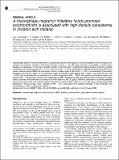A macrophage migration inhibitory factor promoter polymorphism is associated with high-density parasitemia in children with malaria

View/
Publication Date
2006Author
GA Awandare, C Ouma, CC Keller, T Were, R Otieno, Y Ouma, GC Davenport, JB Hittner, JM Ong'Echa, R Ferrell, DJ Perkins
Metadata
Show full item recordAbstract/
Macrophage migration inhibitory factor (MIF) is a pleiotropic cytokine that regulates innate and adaptive immune responses to bacterial and parasitic infections. Functional promoter variants in the MIF gene influence susceptibility to inflammatory diseases in Caucasians. As the role of genetic variation in the MIF gene in conditioning malaria disease outcomes is largely unexplored, the relationship between a G to C transition at MIF −173 and susceptibility to high-density parasitemia (HDP) and severe malarial anemia (SMA) was examined in Kenyan children (aged 3–36 months; n=477) in a holoendemic Plasmodium falciparum transmission region. In a multivariate model, controlling for age, gender, HIV-1 status, and sickle-cell trait, MIF −173CC was associated with an increased risk of HDP compared to MIF −173GG. No significant associations were found between MIF −173 genotypic variants and susceptibility to SMA. Additional studies demonstrated that homozygous G alleles were associated with lower basal circulating MIF levels relative to the GC group. However, stimulation of cultured peripheral blood mononuclear cells with malarial pigment (hemozoin) increased MIF production in the GG group and decreased MIF production in the GC group. Thus, variability at MIF −173 is associated with functional changes in MIF production and susceptibility to HDP in children with malaria.
Collections
- Department of Zoology [161]
